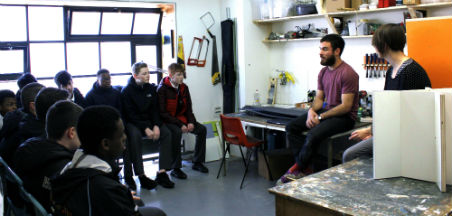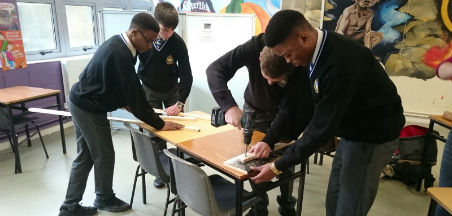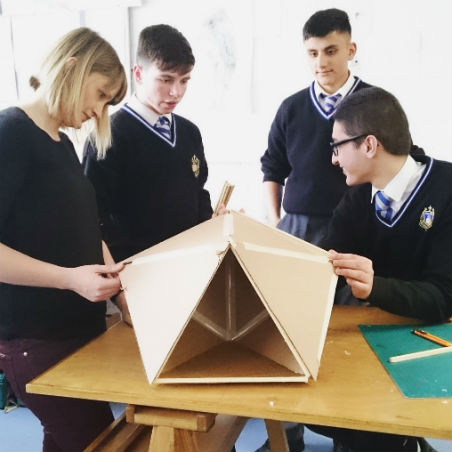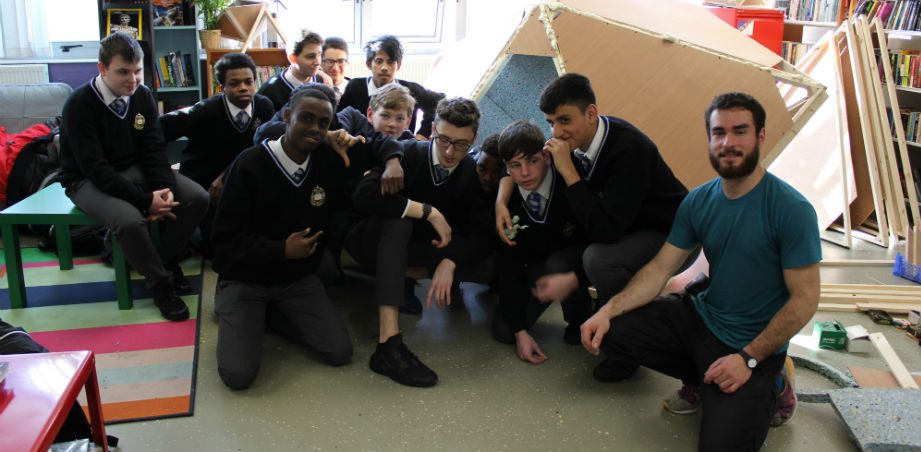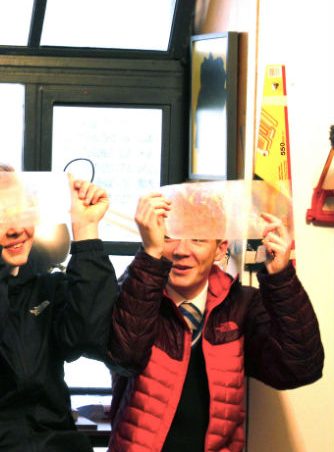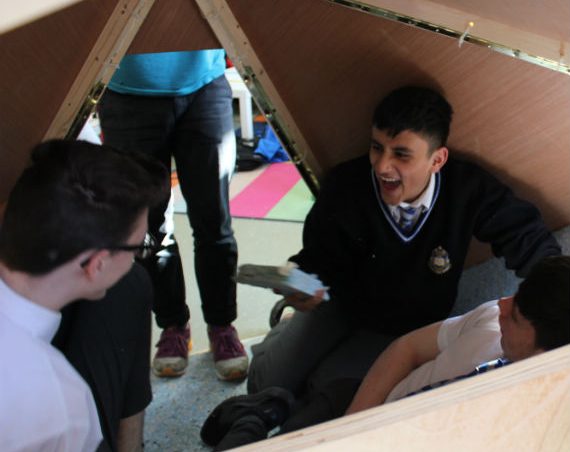Refine by Region
Refine by Art Form
Refine by School Level
Creative Generations – Synge Street CBS collaboration with Andreas Kindler
Tell us the story of your project – What was the impetus? What was it about? Who was involved? How did you begin?
Jean Mann, Creative Generations Education Curator
We have been developing the Creative Generations Arts-in-Education programme over the last four years, and in 2017 we had an opportunity to expand our engagement with a school through a longer term residency. This gave us the chance to make a deeper impact on the students’ learning and awareness of contemporary art. Working with inner city schools in Dublin is part of our remit as a city centre gallery and studio space – so Synge Street was a suitable partner school. This programme is centred around a residency format and creating a space for professional artists to bring their art practice into a school setting; sharing skills, experience and concepts of what contemporary arts practice is today.
Andreas Kindler von Knobloch, Artist
The residency took the form of six sessions in Synge Street Secondary School where I worked together with the teacher and the transition year students on designing and constructing a hang out space for the students to use in their spare time. The goal of these sessions was to think about how to transform the spaces we use and, through some basic construction or alterations, make them more suitable to our needs. Taking their school as the space where they spend most of their time, we looked at the influential work of future thinking architects and artists like Paolo Soleri, Superstudio, Andrea Zittel and N55 as a form of inspiration for our project. From this we then created a sculptural environment for their library.
Student S
Ms Wright brought us to Temple Bar Gallery and Studios, we met Andreas Kindler and Jean and they showed us around the building. Andreas told us what he does and how he works with light. He said he’ll come to the school and do some kind of project together.
Maria Wright Slattery, Art Teacher
Temple Bar Galleries approached our school with the idea of an artist residency, working with students/schools from the local area. Our students began working with Andreas Kindler von Knobloch under the Creative Generations Education Programme. Creative Generations is generously funded by Central Bank of Ireland. The students worked collaboratively to create a new artwork that engaged with the architectural landscape of our school and one that created a special space for the TY students.
How were the ideas developed and how did the young people, artist and teacher work together?
Jean Mann, Creative Generations Education Curator
The residency started with students visiting Andreas in his TBG+S Studio to see where he works, and get an insight into his methods, motivations and inspirations as an arts practitioner. It was from here that a relationship was developed, which continued in the school, where Andreas shared with students the main drivers in his work, and together the artist and students set about making a collaborative piece which incorporated some of these themes and discussions.
Andreas Kindler von Knobloch, Artist
For our first session we worked with Plato’s five basic geometric forms and used them as inspiration in order to come up with a design. Working in groups the students made cardboard models using the basic principles of the platonic solids which are forms made out of equilateral facets. We then chose the most successful model as the basic plan for the larger final structure. Using basic tools and materials such as hammers, drills, nails, screws, cable ties, plywood and 2×1 lengths of wood, we built a structure based on the geometry of the equilateral triangle. Through this building process the students learnt some of the skills that can then be applied in order to build almost any small structure.
Student H
Andreas gave us a powerpoint presentation to inspire us and give us an idea of what he planned to do with us. We all then made a model of the structure we planned to make using cardboard. After deciding on a structure, we began making it using wooden triangles, nails, screws and other materials.
Student S
Andreas gave us a powerpoint presentation and told us how we can mess around with triangles to make a shape of artists and architecture that inspire him.
Maria Wright Slattery, Art Teacher
Firstly the group visited Andreas in his work space in Temple Bar Galleries. For some this was a first experience of meeting a working artist, seeing their workspace and even visiting a gallery space which was an amazing experience in itself. From there, after seeing some of Andreas’s work, he came to visit our school and the creative conversation began within the group. Jean facilitated and guided the conversation within the group which kept things on task. The students gave Andreas and Jean a tour of the school and started the selection process of creating a space for themselves. Giving the ownership and creative discussion over to the students was very empowering to them and it also pushed their maturity and problem solving skills. The students and myself loved the collaborative feel to this project from start to finish.
What was your personal experience of the project in terms of successes and challenges?
Andreas Kindler von Knobloch, Artist
For me it was really exciting to be able to share my practice with this group of students and to work together with them to create an interesting new structure. The greatest challenge was organising the sessions in a way that there were enough tasks and tools for everyone. It was a large group of students and at times it was difficult to keep them all engaged. Our first attempt at the larger structure failed. One of the successes of the project was showing them how to learn from that failure and use it as a way of stepping forward instead of a setback.
Jean Mann, Creative Generations Education Curator
The collaborative nature of Andreas’s practice, coupled with his strong technical skills and methodologies, meant he was very suitable for the residency format. The students learnt a great deal from him, in all sorts of ways. They learned practical and technical methods but also visualisation, problem solving and perseverance, along with the teamwork aspect of constructing as a group on a large scale.
Student K
Building the structure we thought about was very challenging cause it’s not a small structure – it’s huge and we need a lot of materials to make it work. We failed once and the structure fell cause it wasn’t strong enough so we tried again and the second time we succeeded and it was a successful teaming up with everyone.
Maria Wright Slattery, Art Teacher
Like every creative project it is going to run into problems and this project hit a slump on weeks 3–4 and I strongly feel that was where the greatest learning was for the students and also in the running of this programme looking forward. I have to commend Andreas and Jean for how they dealt with the loss of interest on the students’ part. They pulled the project back to the discussion and design stage and helped / guided the TY students to see a way through this slump.
What was significant for you about the project that is worth sharing?
Andreas Kindler von Knobloch, Artist
One of the most significant parts of the project for me was to be able to share my interest and passion for innovative architectural design and see the students respond so positively to it. They really took to some of the ideas and there were some really ambitious plans suggested in the planning stages that in the end were not feasible in the time that we had. The support structures that were in place for me to carry out this residency were essential. If it had not been for Jean Mann and for the support offered by the school and Temple Bar Gallery + Studios it would have been a much more difficult experience.
Jean Mann, Creative Generations Education Curator
For me the residency demonstrated the possibilities that can occur if an artist is given free reign to bring their practice into the classroom, and allow students to become active participants in the process of art making.
Student D
I really enjoyed working with the team on such a big project that was on such a large scale.
Student K
The successful teamwork we did was worth sharing and the enjoyment I felt doing art through building something.
Student J
I enjoyed working with the drills and hammer.
Maria Wright Slattery, Art Teacher
This was a project that Synge St students would not have been able to experience due to its sheer size and the construction skill set involved. The students absolutely loved working with Andreas and using all the ‘man tools’ as they referred to them. This project encapsulates the hands-on approach that Synge Street wanted the TY students to experience. Everything they were learning from their books, measurements in maths, topics from science class to communication skills from English class were all played out during their weekly sessions in a practical manor on this project.
This was a fantastic learning experience for both my students and myself. The TY students are very proud of their seating pod which has found its home in our school library. There was a huge amount of creative learning involved in this project with Andreas showing some of the lads how the tools worked for the construction process! Life skill learning was paramount in this project and as the coordinator, this was exactly what I was looking for, for my students. It is amazing to even watch back over the short film and see the students’ confidence grew.
Has anything changed in your work as a result of the project?
Andreas Kindler von Knobloch, Artist
Working collectively is a big part of my practice. This project was very useful for me to see how I might be able to extend that collaborative element to a wider group of people. Since that project I have gone on to make structures that are assembled collaboratively with large groups of people which in part came from this experience.
Student D
My view of art has changed because up until now I thought of art as a much more individual thing to do, but not on bigger projects where everyone can use teamwork and work together.
Student F
My view of art has changed because I didn’t think that what we were doing was a piece of art until the end of the project.
Student S
I thought it was impossible to build something like that, but the result told me that I’m capable of developing my ideas and make it happen.
Student A
I really enjoyed the freedom we got from doing.
Student H
I associated art with picture and drawings and this gave me the knowledge that art can take any form.
Student K
At first, I thought Art was boring but when we did this project I enjoyed everything that is part of the project – and it’s all about art!
Maria Wright Slattery, Art Teacher
From working on this project my own teaching has taken on an edgier element. I’m not afraid of bigger projects and to hand over ownership to my students and trust that they will find a solution with maybe less input from me! I have probably learned to trust the students more and trust their creativity.
Spotlight
Artist(s):
Andreas Kindler Von Knobloch
Andreas Kindler von Knobloch is a visual artist currently based in Dublin. He works both solo and collaboratively with a focus on ideas of collectivity and participation, through the creation of
structures, objects and spaces that question our material and social relations.
Currently he is researching language and architecture as the two overarching systems through which we engage with the world. Within these systems, he is interested in miscommunication, openness and uncertainty as elements that create space for engagement.
His collaborative practice involves working with artists Tom Watt and Tanad Williams. Their work engages in overlooked elements in public architecture.
Recent exhibitions include: Making Space, in collaboration with Will Moss and Laura O’Quinn, presented at West Coast Craft, Fort Mason, San Francisco, USA. Living Practice, Leland Residency
exhibition, PNCA, Portland, OR, USA, 2016. Brute Clues, in collaboration with Tom Watt and Tanad WIlliams, curated by Tessa Giblin, Project Arts Centre, Dublin Ireland 2016. A Fair Land, Grizedale and Irish Museum of Modern Art (IMMA) Dublin, August 2016. In Support, a solo exhibition, Mermaid Arts Centre, Bray, Co. Wicklow, Ireland, 2016. Limited Time Only, MFA graduation show, Portland, OR, USA 2016.
Teacher(s):
Maria Wright, Art Teacher & School Program Coordinator.
I am graduate from The National College of Art and Design with a Hons BA in Art, Design & Education. I have been working in CBS Synge Street Dublin 8 for 11 years. I love the creativity that my job and students bring into my life. Each day is different and exciting working with my students. This project has injected a new lease of life into the world of visual arts within our school and has opened up lots of new avenues for our students.
Other:
(Curator, agency, etc):
Jean Mann Creative Generations Education Curator
Jean Mann is an independent art education curator, with a training in fine art and post-primary education. She has worked on and managed programmes for Temple Bar Gallery + Studios, the Royal Hibernian Academy and Dublin Contemporary 2011. Jean has a particular interest in creating platforms for artists to share contemporary art practice with new audiences from the youth and community sectors. Jean supports artists, school students and staff to work together in a shared capacity. With her background in art and education she is well placed to see the needs of all stakeholders and create a mutually beneficial learning environment.
Temple Bar Gallery and Studios
Temple Bar Gallery + Studios (TBG+S) is a contemporary art gallery and artists’ studio in Dublin city centre. TBG+S aims to support the development of artists and facilitate the production of art through high quality studio provision and a progressive exhibition programme.
TBG+S aims to cultivate an environment of learning and creativity and support close engagement of audiences of all ages with Irish and international artists and their work.
The extensive programme of public engagement includes studio and gallery tours, lectures, critical discussions, music events, live art events and performances, readings and reading groups, workshops and film screenings for all types of audiences. A parallel education programme works with primary and secondary school pupils in Dublin city.
TBG+S is funded through annual funding from the Arts Council of Ireland and Dublin City Council.
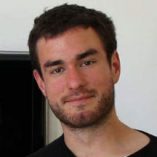
Artist(s)
Andreas Kindler von Knobloch
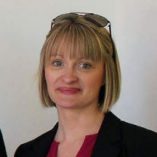
Teacher(s)
Maria Wright Slattery
Artforms
School Level
School/
Participant Group
Synge Street CBS, Dublin City
No. Participants
18
Region
Age/Class
Transition year pupils
Dates
Spring term February - May 2017
Weblinks
Leading Agency
Temple Bar Gallery & Studios
Other Partners and/or Funders
Central Bank of Ireland
Key themes/ lines of enquiry
Creating a platform for artists to bring contemporary art practice into a classroom environment.
Supporting students to engage with contemporary sculpture and to work collaboratively to create their own site-specific work.
Curriculum Strands
Visual Art education
Also links with Construction Studies
I thought it was impossible to build something like that, but the result told me that I’m capable of developing my ideas and make it happen.
Student S, Synge Street CBS
